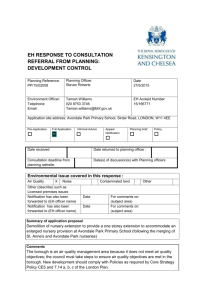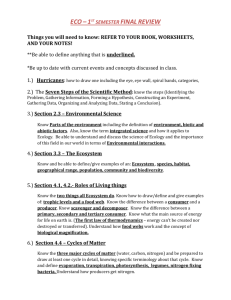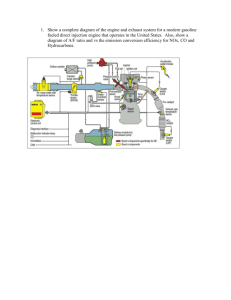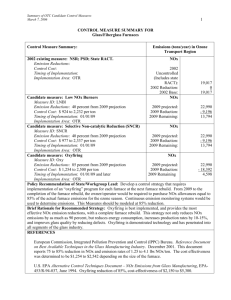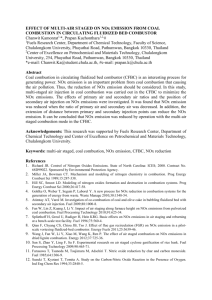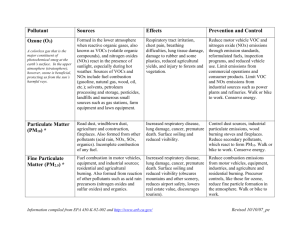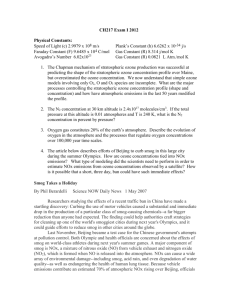HHC Presentation to SCAQMD
advertisement
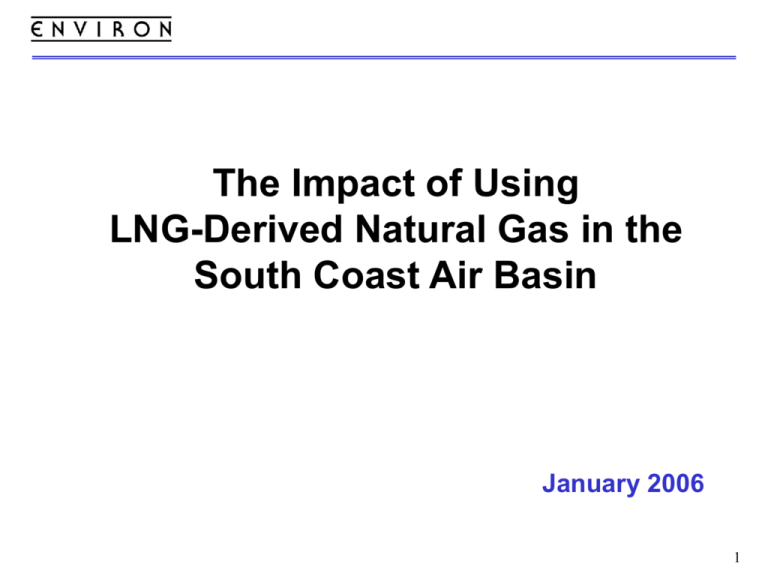
The Impact of Using LNG-Derived Natural Gas in the South Coast Air Basin January 2006 1 Background • Future natural gas demand in the United States will rise • Traditional natural gas sources are increasing in cost and new supplies will not meet demand • Regassification of LNG imports is commercially feasible and economically beneficial • Imported LNG typically has higher heat content (HHC) than current NG in the South Coast – More ethane, propane, butane – Less N2, CO2, and O2 2 Air Quality Background • South Coast is a severe-17 ozone non-attainment and serious PM10 non-attainment area – NOx is an ozone and PM10 precursor – 2003 AQMP: reduce NOx 48% from 2003 to 2010 • Combustion of HHC (e.g. LNG-derived) NG may increase NOx and CO emissions from some types of equipment • 2003 AQMP control measure MSC-07 proposes upper limit on heating value – Condensing (e.g. extracting) out higher hydrocarbons – Adding inerts (e.g. N2, CO2) • Question: what would be the impact of HHC NG on South Coast emissions and air quality? 3 Impact Analysis Approach • Review relevant emission inventories for SCAB natural gas combustion emission categories – Compare to overall SCAB inventory • Review equipment test data comparing the emissions from HHC gas combustion to base gas combustion • Apply emission ratio to SCAB stationary source natural gas combustion inventory categories and assess the inventory impact • Apply applicable SCAQMD regulatory limits, where possible – assess inventory impact 4 SCAB Emission Inventory tons/day 1200 1049 1000 807 800 600 454 400 308 200 15 5 53 0 VOC CO/10 NOx Natural Gas Combustion 63 2 SOx 7 PM10 Total Source: CARB, 2003 Inventory for SCAB, anthropogenic only 5 Contributions to 2003 NOx Inventory All Mobile 90% Remaining Sources 2% NG-Industrial 3% * Other Fuel Combustion 3% 1049 tons/day NOx NG-Residential 2% Stationary Source Combustion Sources * Other fuels include diesel, propane, distillate oil, LPG, gasoline, etc. 6 South Coast Energy from Different Fuels Gasoline 47% Diesel 8% Natural Gas 45% Total energy consumed: 1,723,000 Bbtu/year Based on reported fuel consumption from 2000 Fuel Tax Report, SoCalGas 7 HHC Emission Studies • Initial SoCalGas sponsored tests of gas-fired equipment (2005 Final Report, SoCalGas) – Tests used NG with higher heating values and Wobbe numbers, compared to base gas – Wobbe = heating value / square root of specific gravity – Equipment was NOT modified / adjusted for HHC gas • Gas #6 (HHV=1100, Wobbe=1400) results were used in the analysis – Gas #3 (HHV=1150, Wobbe=1430) used for residential forced air heating units since equipment was not tested on Gas #6 – 2003 LNG Research Study – Phase I for IC engines 8 NOx Test Results for Base and HHC Gas (Gas #6) * CHART 5: NOx Test Results for Base and HHC Gas (Gas 6) Emissions (ppm @ 3% O2) 140 133 NOx Base Gas Emissions NOx Gas Six Emissions 120 111 101 Emissions (ppm @ 3% O2) 100 90 89 88 80 66 64 60 54 39 40 20 52 16 3 3 7 10 ICE 0 Commercial Water Boiler Horizontal Condensing FAU Legacy Water Heater ICE Ultra Low NOx Steam Boiler Wall Furnace Instantaneous Water Heater Commercial Conveyor Broiler Note: For HCFAU, 2003Category LNG Study Report results (after controls) Source * * Gas #3 * results * used. For ICE, ENVIRO 9N * The test results which were applied to Scenario 1 and 2 test results. Emission Impact Analysis • • • • Total Basin natural gas usage: 2.04 Bcf/day Assessed the emission impact from two scenarios: 1. Replacement of 1 Bcf/day with HHC gas 2. Replacement of 0.5 Bcf/day with HHC gas Adjusted the emissions from each source category with related test results Assessed impact for the effect of certain SCAQMD rules 10 Applicable Test Results Tested Equipment1 Source Category 2003 NOx Emissions (tons/day) Internal Combustion All ICEs Engine2 6.9 Commercial Water Boilers All boilers categories 7.8 HCFAU3 Residential, service and commercial space heating 10.6 Legacy water heater Residential, service and commercial water heating 10.7 None available (no adjustment) 16.9* gas turbines, oven heaters, in-process fuel, other * 5.8 tpd from residential (cooking and other) and 3.3 tpd from gas turbine engines generally 1. 2. in RECLAIM 3. LNG study April 2005, except as noted LNG Research Study – Phase 1, 2003 Gas #3 results used 11 Rule Adjustments • Almost all in basin sources that emit over 4 tons/day of NOx are in RECLAIM – Net Basin change in emissions from those sources would be zero • RECLAIM applied to: – All electric utilities, co-generation, oil / gas production, petroleum refining, and industrial / manufacturing categories • No rule or permit limits applied to any other categories 12 NOx Impact of HHC Gas CHART 8b: NOx Emission Impacts for HHC Gas Scenarios 1200 NOx tons/day 1044.8 Emissions (ton/day) 1000 2003 SCAB NG Combustion Emissions Scenario 1 (1 Bcf HHC Gas) Scenario 2 (0.5 Bcf HHC Gas) 2003 Total Emissions 800 600 400 200 52.9 54.1 53.5 0 Total 2003 NOx Emissions Test-adjusted NG emissions with RECLAIM impact ENV I RO N 13 Seasonality • Ozone season is summer/early fall • Emissions are seasonal – Greater electrical generation in summer • Sources under RECLAIM, BACT – Residential emissions reduced in summer • No space heating July through October • Reduced water heating needs • Pool heaters not used during hottest periods – Commercial/Industrial – less seasonality 14 VOC Emission Impacts Chart 2: VOC Test Results for Base and HHC Gas (Gas 6) 400 Emissions (ppm @ 3% O2) Base Gas LNG 350 Emissions (ppm @3% O2) 394.0 300 232.8 250 230.0 215.0 200 150 100 50 76.8 37.5 31.2 22.8 3.8 10.3 3.3 1.6 1.2 1.6 0 Ultra Low NOx Steam Boiler Legacy Floor Instantaneous Commercial Furnace Water Heater Water Boiler Wall Furnace ICE Low NOx Steam Boiler Sourcereduction Category Analysis shows a 0.8 ton/day for Scenario 1 15 Latest SCAQMD Modeling Analysis • Black lines are ozone episode isopleths • Colored lines are annual average PM2.5 isopleths Ozone decreases as NOx increases PM2.5/PM10 insensitive to NOx changes Ozone and PM2.5/PM10 decrease as VOC decreases Source: SCAQMD, 2007 AQMP Technical Advisory Group, 12/7/05 16 Other Air Quality Impact Issues • NOx emissions from residential and service / commercial sources are spread throughout the SCAB – For example, emissions changes in San Fernando Valley do not affect peak Inland Empire areas • Weekday/Weekend Effect – Natural gas usage 13% higher on weekdays, but 65% of ozone exceedences occur on weekends • Uncertainty in mobile source emissions greater than potential NOx increase due to HHC combustion • Air quality modeling possible, but may be insensitive to such small emission changes Ozone and PM2.5/PM10 air quality impacts expected to be negligible, with impact potentially beneficial 17 Preliminary Conclusions • 0.11% annual increase in NOx emissions if 1.0 Bcf/day of LNG-derived natural gas is used – 0.06% increase for 0.5 Bcf/day – Does not account for reductions from proper tuning – Does not account for non-RECLAIM emission limits • Ozone and PM10 air quality impact expected to be negligible, with impact potentially beneficial • Given the small potential impact, other more costeffective, local approaches should be considered – Expanded use of natural gas instead of higher emitting diesel and gasoline 18
